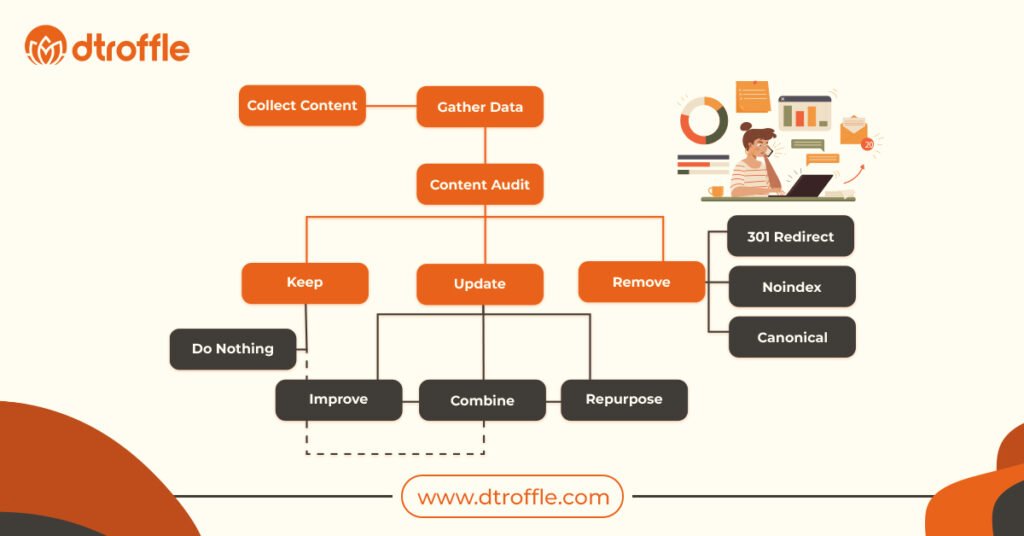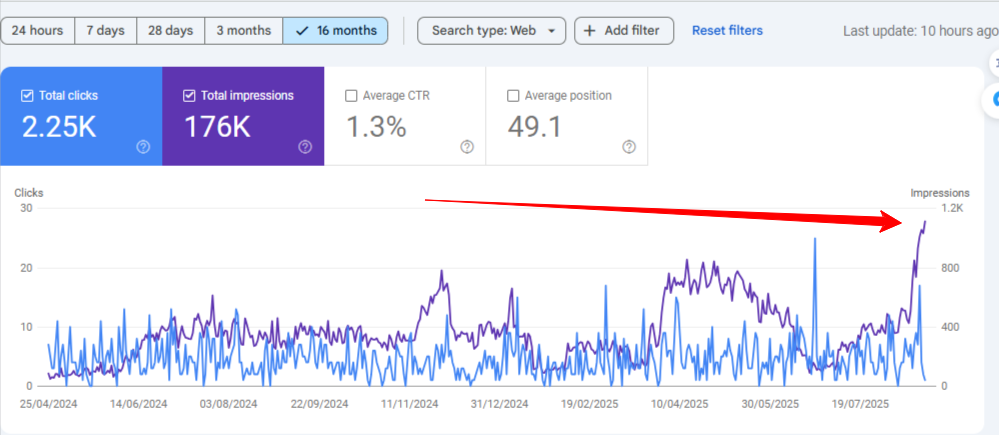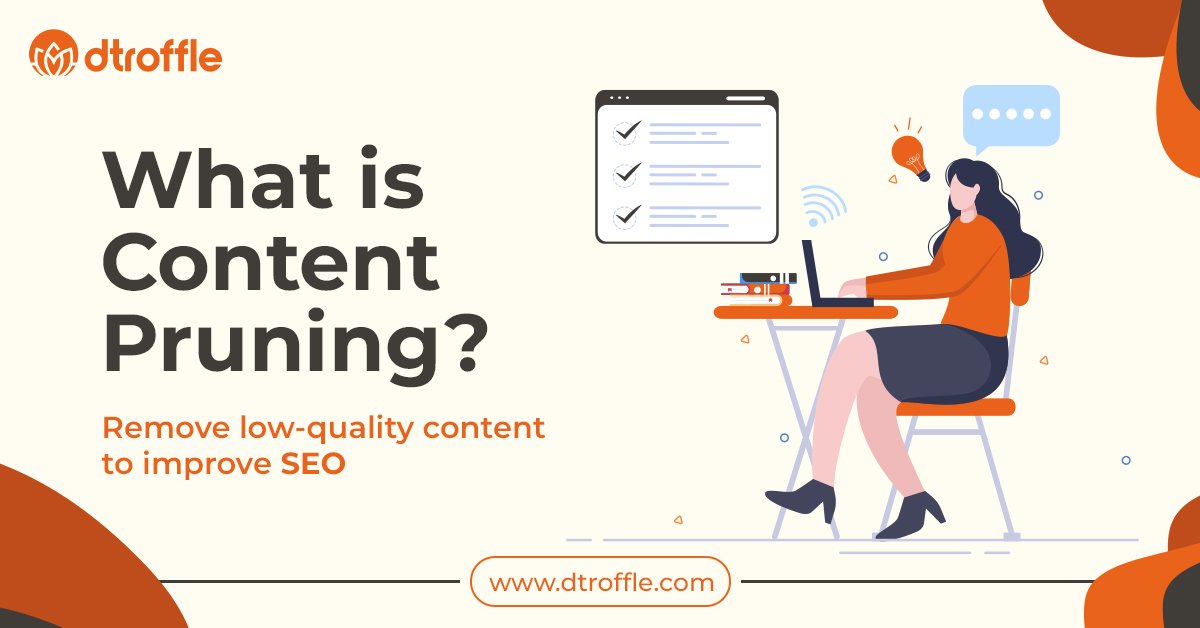Content Pruning: When you hear the word pruning, you probably think of trimming a tree or plant so it can grow healthier and stronger. The process of content pruning involves identifying low-quality, duplicate, or weak content that is weighing down your website, auditing it, trimming or removing it, and updating it by adding high-quality content.
By removing poor or unhealthy content, you can make space for material with growth potential, thereby improving your website’s performance.
At DTROFFLE, a leading digital marketing agency based in Agra, India, where we offered digital marketing services to businesses. we’ve worked with several websites struggling to grow due to some hidden problems Duplicate content, thin content, and outdated content. Very often, businesses publish content regularly but forget to revisit it later. As a result, their websites get cluttered with irrelevant, low-performing pages that hold back overall SEO growth.
In this article, we will explain how you can identify low-value or underperforming content, implement a content pruning strategy, and use it to boost site quality, crawlability, and SEO performance. Our content and SEO team has successfully improved the organic traffic of many websites by applying effective content pruning strategies, at the end of this article, we will share the status of an ongoing content pruning strategy and their effects, at the end of this article. but first let’s understand content pruning really is, why it matters, and how you can do it step by step.
What Is Content Pruning?
Content pruning means reviewing your website and deciding which pages, blogs, or posts should stay, which ones need updating, and which should be removed.
In other words:
Content pruning is the process of analyzing your website’s content to identify low-value or underperforming pages that are dragging down your website, then updating (Content Repursposin), merging, or removing them to improve overall site quality, crawlability, and SEO performance.
Think of it like cleaning out your closet: when you remove old, unused, or worn-out clothes, you make space for the ones that actually fit, look good, and add value to your wardrobe. In the same way, content pruning ensures your website only keeps the content that is useful, relevant, and impactful.
But the question is, what type of content can you consider a burden on your website?
The answer is, pages on your website that have lost their usefulness.
Tips to identify these pages:
- Pages with outdated content or information.
- Pages with duplicate or thin content.
- Pages that are not getting clicks and impressions.
- Pages that haven’t brought much traffic to your website, or in some cases, haven’t even received any impressions.
- Get little to no traffic
- Target the wrong keywords
If you leave this type of content untouched, it can drag your whole site down in the eyes of both Google and your visitors.
Why Should I Care About Content Pruning?
You should care about content pruning because outdated or underperforming content can weaken your website’s authority and SEO performance. Search engines favor fresh, reliable, and high-quality content, so trimming or updating low-value pages helps your site stay competitive. Content strategists are often driven to prune after algorithm updates or core changes-most notably with the rise of Google’s E-E-A-T principles and the Helpful Content System. These updates encourage website owners to self-assess content for usefulness, expertise, and trustworthiness. By pruning irrelevant or low-performing pages, you can improve:
- Crawlability: Do you want search engine crawlers to spend your crawl budget on pages that are truly important for your website? If yes, then content pruning is an effective strategy that can help you achieve this.
- Batter User Experience: When visitors find only useful, relevant, and updated content on your site, they stay longer, interact more, and leave with a positive impression, which is increasingly become important for search engines.
- Build a Stronger Link Equity: By pruning low-value content, you ensure that your website’s link authority is directed toward pages with real growth potential.
- Authoritative Digital Presence: By maintaining only high-quality, trustworthy, and relevant content, you position your website as a credible source in your industry, strengthening brand authority and search engine trust.
- Improves SEO Performance: Search engines prioritize fresh, high-quality content. Outdated or irrelevant content can dilute the effectiveness of your site’s SEO strategy. Removing low-performing content allows search engines to focus on your best and most relevant pages. This can lead to better rankings and increased visibility for your valuable content.
How to Implement Content Pruning | Step By Step Guide

1. Collect Content:
- The first step of content pruning strategy is to gather a complete inventory of your website content.
- This includes your website’s blog post, landing pages, category pages, and FAQs.
- You can use tools like SEMrush, Ahref, Screeming Frog (My Favorate), Sitebulb, or Google Search Console to gather this data.
Goal: Get a master list of all content that needs to be revieved.
2. Gather Data:
Collect performance metrics for each page. This helps you understand which content works and which doesn’t. Key data points to gather:
- Traffic (sessions, page views).
- Engagement metrics (bounce rate, average time on page, exit rate).
- SEO performance (keyword rankings, impressions, clicks).
- Conversions (leads, sales, signups).
- Backlinks (quality and quantity).
Goal: Build a data-driven picture of how each piece of content is performing.
3. Conduct a Content Audit:
With the content list and performance data, run a content audit to assess the value of each page. During the audit, ask few questions from yourself:
- Does this content attract traffic?
- Does it rank for relevant keywords?
- Is it up-to-date and accurate?
- Does it serve user intent?
- Is it duplicated or overlapping with another page?
Goal: Decide whether to keep, update, or remove content.
4. Decide on Actions (Keep, Update, Remove)
I. Keep Content:
Keep Content refers to content that is already performing well and continues to provide value to your audience. Such pages generally rank high in search engines, drive consistent traffic, and remain relevant over time. In these cases, you may choose to do nothing and leave the content as it is, especially if it is evergreen and still accurate.
Action: However, even strong-performing content can often be improved further. This can be done by adding updated statistics, incorporating fresh visuals, enhancing the formatting for readability, or strengthening both internal and external linking. These small improvements not only help maintain rankings but can also ensure that your content stays competitive and continues to meet user intent effectively.
II. Update Content
Update Content applies to pages that still have potential but require a refresh to perform better. These pages may contain outdated information, lack depth, or underperform in search rankings despite having valuable insights.
Action: In such cases, the content should be improved by rewriting weak sections, adding missing details, optimizing with relevant new keywords, and fixing any formatting issues to enhance readability. Another effective approach is to combine multiple thin or overlapping articles into one comprehensive, in-depth guide that covers the topic thoroughly, eliminating redundancy and strengthening authority.
Additionally, existing content can be repurposed into different formats such as videos, infographics, podcasts, or downloadable resources to reach a wider audience across multiple platforms. By updating content strategically, you ensure that valuable pages remain relevant, useful, and competitive in search rankings.
III. Remove Content:
Remove Content is necessary for pages that are irrelevant, duplicate, or simply too weak to improve. Keeping such content on your site can harm SEO performance, confuse users, and waste search engine crawl budget. Removing or de-prioritizing these pages ensures that only high-quality, valuable content remains visible to both users and search engines.
Action:
- 301 Redirect: One effective way to handle outdated or irrelevant content is to set up a 301 redirect. This ensures that users and search engines are seamlessly guided to a more relevant page, preserving SEO value and preventing traffic loss.
- Noindex: In cases where you want to keep the content live for users but prevent it from appearing in search results, applying a noindex tag is the best option. This allows the page to remain accessible while ensuring search engines don’t waste resources indexing it.
- Canonical Tag: When duplicate or very similar pages exist, a canonical tag can be used to point search engines toward the preferred version. This helps consolidate ranking signals and avoids content duplication penalties.
5. Monitor and Review Regularly
Finally, once the pruning process is complete, it’s essential to monitor results. Keep track of organic traffic, keyword rankings, crawl efficiency, and engagement metrics after pruning to measure improvements. Since search engines and user behavior change over time, content pruning should be repeated regularly ideally every six to twelve months to keep your website fresh, competitive, and SEO-friendly. In short, content pruning ensures your site focuses on quality over quantity, helping both users and search engines find the most relevant and authoritative information on your website.
Is Content Pruning Only Useful for Large Websites?
No, pruning content is not only useful for large websites. While big websites with thousands of pages benefit greatly-since pruning helps manage crawl budget and eliminate thin content, smaller websites can also see strong results. Even if your site has fewer pages, outdated or low-quality content can still harm SEO performance, confuse users, and reduce trust. Regularly reviewing and improving your content ensures that every page adds value, stays relevant, and aligns with search intent. Whether large or small, any website can boost visibility, user experience, and authority by applying a smart content pruning strategy.
How Often Should You Prune Your Wesite Content?

You should prune your website content on a regular basis, but the exact frequency depends on your site size and publishing activity. For most websites, a comprehensive content audit every 6 to 12 months is ideal. Large websites with thousands of pages may benefit from quarterly reviews, while smaller sites can manage with annual audits. Additionally, you should consider pruning whenever major Google algorithm updates roll out, as these often change how content quality is evaluated. Regular pruning ensures your content stays fresh, relevant, and SEO-friendly, while preventing outdated or underperforming pages from harming your site’s performance.
Case Study: How Dtroffle Used Content Pruning to Boost Organic Growth
At DTROFFLE, a leading digital marketing agency based in Agra, Uttar Pradesh, we’ve handled several websites where outdated content was a major issue. One such case showed us how powerful Content Pruning can be.
When we first analyzed the website, it was on the verge of getting almost no clicks. After applying our 20% Content Pruning Strategy, the results were instant and dramatic in Google Search Console. Within just one month, the website’s impressions shot up to their highest level in the past 16 months.
While the growth in organic clicks is still in progress, the current trend clearly shows that similar improvements will soon reflect there as well. This is present case and our team is still work on it, and we will continue to share upcoming results as the strategy unfolds.

If your website is struggling with declining traffic and you want to see it grow again in organic search results, feel free to get in touch with us.
Want to apply content pruning strategy on your website to remove unneccessory outdated, thin or duplicate content, to improve website SEO performance.





